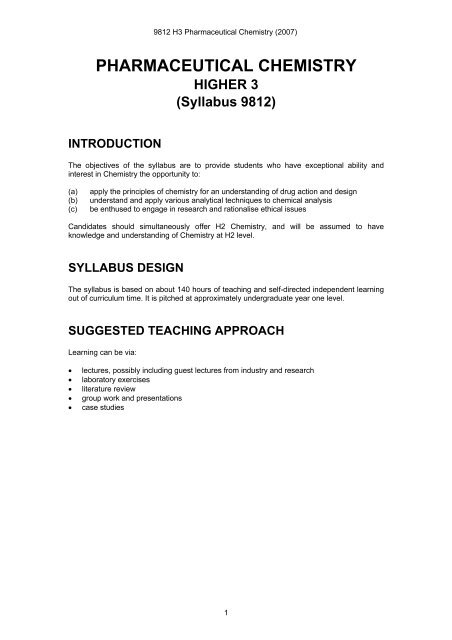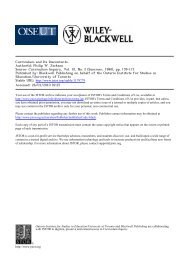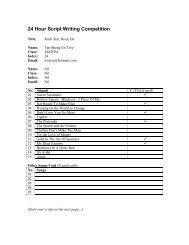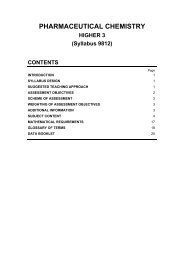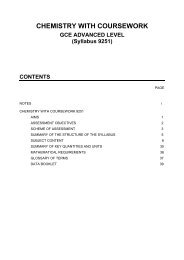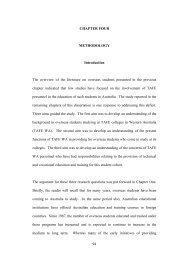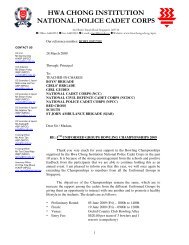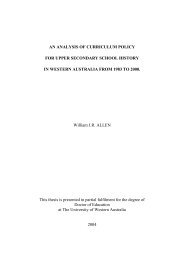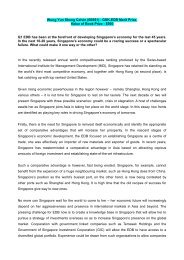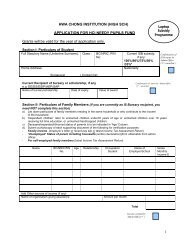PHARMACEUTICAL CHEMISTRY - Nanyang Junior College
PHARMACEUTICAL CHEMISTRY - Nanyang Junior College
PHARMACEUTICAL CHEMISTRY - Nanyang Junior College
You also want an ePaper? Increase the reach of your titles
YUMPU automatically turns print PDFs into web optimized ePapers that Google loves.
9812 H3 Pharmaceutical Chemistry (2007)<br />
<strong>PHARMACEUTICAL</strong> <strong>CHEMISTRY</strong><br />
HIGHER 3<br />
(Syllabus 9812)<br />
INTRODUCTION<br />
The objectives of the syllabus are to provide students who have exceptional ability and<br />
interest in Chemistry the opportunity to:<br />
(a)<br />
(b)<br />
(c)<br />
apply the principles of chemistry for an understanding of drug action and design<br />
understand and apply various analytical techniques to chemical analysis<br />
be enthused to engage in research and rationalise ethical issues<br />
Candidates should simultaneously offer H2 Chemistry, and will be assumed to have<br />
knowledge and understanding of Chemistry at H2 level.<br />
SYLLABUS DESIGN<br />
The syllabus is based on about 140 hours of teaching and self-directed independent learning<br />
out of curriculum time. It is pitched at approximately undergraduate year one level.<br />
SUGGESTED TEACHING APPROACH<br />
Learning can be via:<br />
• lectures, possibly including guest lectures from industry and research<br />
• laboratory exercises<br />
• literature review<br />
• group work and presentations<br />
• case studies<br />
1
9812 H3 Pharmaceutical Chemistry (2007)<br />
ASSESSMENT OBJECTIVES<br />
A<br />
Knowledge with understanding<br />
Students should be able to demonstrate knowledge with understanding in relation to:<br />
1. scientific phenomena, facts, laws, definitions, concepts, theories;<br />
2. scientific vocabulary, terminology, conventions (including symbols, quantities<br />
and units);<br />
3. scientific instruments and apparatus, including techniques of operation and<br />
aspects of safety;<br />
4. scientific quantities and their determination;<br />
5. scientific and technological applications with their social, economic and<br />
environmental implications;<br />
The Syllabus Content defines the factual knowledge that candidates may be required<br />
to recall and explain. Questions testing these objectives will often begin with one of the<br />
following words: define, state, describe, explain or outline. (see the Glossary of Terms.)<br />
B<br />
Handling, applying and evaluating information<br />
Students should be able in words or by using symbolic, graphical and numerical forms<br />
of presentation to:<br />
1. locate, select, organise and present information from a variety of sources;<br />
2. handle information, distinguishing the relevant from the extraneous;<br />
3. manipulate numerical and other data and translate information from one form to<br />
another;<br />
4. analyse and evaluate information so as to identify patterns, report trends and<br />
conclusions, and draw inferences;<br />
5. present reasoned explanations for phenomena, patterns and relationships.<br />
6. construct arguments to support hypotheses or to justify a course of action;<br />
7. apply knowledge, including principles, to novel situations;<br />
8. evaluate information and hypotheses.<br />
9. demonstrate an awareness of the limitations of Chemistry theories and models.<br />
10. bring together knowledge, principles and concepts from different areas of<br />
chemistry, and apply them in a particular context.<br />
11. use chemical skills in contexts which bring together different areas of the subject.<br />
2
9812 H3 Pharmaceutical Chemistry (2007)<br />
These assessment objectives cannot be precisely specified in the Syllabus Content because<br />
questions testing such skills may be based on information which is unfamiliar to the<br />
candidate. In answering such questions, candidates are required to use principles and<br />
concepts that are within the syllabus and apply them in a logical, reasoned or deductive<br />
manner to a novel situation. Questions testing these objectives will often begin with one of the<br />
following words: predict, suggest, construct, calculate or determine. (see the Glossary of<br />
Terms.)<br />
SCHEME OF ASSESSMENT<br />
Candidates will take a 2 h 30 min paper (100 marks total). Candidates choose five out of six<br />
free-response questions. Each question carries 20 marks, and requires integration of<br />
knowledge from the different sections in the syllabus.<br />
WEIGHTING OF ASSESSMENT OBJECTIVES<br />
A<br />
B<br />
Assessment Objectives<br />
Knowledge with<br />
understanding<br />
Handling, applying and<br />
evaluating information<br />
Weighting<br />
30%<br />
70%<br />
ADDITIONAL INFORMATION<br />
Data Booklet<br />
A Data Booklet is available for use in the examination paper. The booklet is reprinted at the<br />
end of this syllabus document.<br />
Nomenclature<br />
Students will be expected to be familiar with nomenclature used in the syllabus but otherwise<br />
the ASE (The ASE Companion to 16-19 Science) conventions will be used.<br />
In particular, the names sulphite, nitrite, sulphur trioxide, sulphurous acid and nitrous acid will<br />
be used in question papers.<br />
3
9812 H3 Pharmaceutical Chemistry (2007)<br />
SUBJECT CONTENT<br />
1. EFFECTS AND DEVELOPMENT OF DRUGS<br />
This section introduces the general properties and functions of drugs. It gives a general<br />
idea of how drugs are designed, developed, and tested, including the use of structural<br />
modification, asymmetric synthesis to get the desired optical isomer, and drug testing<br />
made before drugs are introduced to the public. Candidates should be aware of the<br />
contribution that science has made (and continues to make) towards maintaining the<br />
health and well-being of the world’s population.<br />
1.1 EFFECTS OF DRUGS<br />
Learning Outcomes<br />
Candidates should be able to:<br />
(a)<br />
(b)<br />
(c)<br />
(d)<br />
list the general effects of drugs<br />
identify the properties of an ideal drug<br />
recognise the importance of the body’s natural healing processes<br />
recognise the implications of the placebo effect<br />
1.2 DEVELOPMENT OF DRUGS<br />
Learning Outcomes<br />
Candidates should be able to:<br />
(a)<br />
(b)<br />
(c)<br />
(d)<br />
(e)<br />
describe the various aspects of a drug discovery program<br />
understand the different sources of potential drug candidates<br />
explain the modification of molecular structure to optimise drug activity<br />
describe the importance of stereochemistry in drug action, and the use of<br />
asymmetric synthesis to get the desired optical isomer<br />
describe the basic steps in drug testing<br />
4
9812 H3 Pharmaceutical Chemistry (2007)<br />
2. PROPERTIES OF FUNCTIONAL GROUPS AND INTERMOLECULAR<br />
INTERACTIONS<br />
This section focuses on the properties of some functional groups and ring systems in<br />
drug molecules, and how drug molecules interact with receptors to bring about a<br />
biological effect.<br />
2.1 PROPERTIES OF SOME FUNCTIONAL GROUPS AND RING SYSTEMS IN<br />
DRUG MOLECULES<br />
Learning Outcomes<br />
• Lactones<br />
Candidates should be able to:<br />
(a)<br />
describe the chemistry of lactones in the following reactions:<br />
(i) hydrolysis<br />
(ii) reaction with ammonia<br />
(iii) reduction<br />
• Lactams<br />
Candidates should be able to:<br />
(a)<br />
describe the chemistry of lactams in the following reactions:<br />
(i) hydrolysis<br />
(ii) reduction<br />
• Ethers<br />
Candidates should be able to:<br />
(a)<br />
(b)<br />
describe the preparation of ethers from<br />
(i) alcohols<br />
(ii) Williamson ether synthesis<br />
describe the acidic cleavage of ethers<br />
• Sulphides<br />
Candidates should be able to:<br />
(a)<br />
(b)<br />
describe the preparation of sulphides from the reaction between an<br />
alkyl halide and thiolate ion<br />
describe the oxidation of sulphides<br />
• Thiols and Disulphides<br />
Candidates should be able to:<br />
(a)<br />
(b)<br />
describe the preparation of thiols from an alkyl halide and the<br />
hydrosulphide ion<br />
describe the oxidation of thiols to disulphides, and reduction of<br />
disulphides to thiols.<br />
5
9812 H3 Pharmaceutical Chemistry (2007)<br />
• Furan, Thiophene, Pyrrole<br />
Candidates should be able to:<br />
(a)<br />
compare the relative aromaticity of furan, thiophene, and pyrrole<br />
(b)<br />
describe the electrophilic substitution reactions, as exemplified by<br />
nitration, Friedel-Crafts acylation and alkylation<br />
(c)<br />
explain the effect of electron-withdrawing groups on the reactivity<br />
and position of substitution on the aromatic ring<br />
• Pyridine<br />
Candidates should be able to:<br />
(a)<br />
explain the basicity of pyridine<br />
(b)<br />
explain its inertness to electrophilic substitution<br />
(c)<br />
describe the mechanism of nucleophilic substitution in pyridine<br />
2.2 INTERMOLECULAR FORCES AND RECEPTOR INTERACTIONS<br />
Learning Outcomes<br />
Candidates should be able to:<br />
(a)<br />
apply their understanding of the following types of bonding to explain how<br />
a general receptor interacts with a drug molecule and changes shape to<br />
bring about a biological effect<br />
(i) covalent bonding<br />
(ii) ionic interaction<br />
(iii) hydrogen bonding<br />
(iv) ion-dipole interaction<br />
(v) van der Waals interaction (based on permanent and induced dipoles)<br />
[Details of types and sub-types of receptors are not required]<br />
(b)<br />
(c)<br />
(d)<br />
understand the effects of competitive and non-competitive inhibition on<br />
drug-receptor interaction<br />
explain the design of agonists and antagonists<br />
use the concept of drug-receptor interactions to explain tolerance and<br />
dependence on a drug<br />
6
9812 H3 Pharmaceutical Chemistry (2007)<br />
2.3 BONDING AND MOLECULAR PROPERTIES OF ORGANIC DRUG<br />
MOLECULES<br />
Learning Outcomes<br />
Candidates should be able to:<br />
(a)<br />
apply their understanding of the effects of the following factors to explain<br />
the behaviour of drug molecules:<br />
(i) hydrophilicity vs hydrophobicity (polarity)<br />
(ii) acidity and basicity<br />
(iii) electronic effects (inductive effects; mesomeric effects)<br />
(iv) steric effect<br />
3. MOLECULAR STEREO<strong>CHEMISTRY</strong><br />
The importance of stereochemistry in drug action is well-known. Different<br />
stereoisomers can have very different biological effects. This section builds on the<br />
study of stereochemistry in H2 Chemistry.<br />
3.1 GEOMETRICAL ISOMERISM<br />
Learning Outcomes<br />
Candidates should be able to:<br />
(a)<br />
(b)<br />
explain the importance of geometrical isomerism to drug action<br />
use the E, Z nomenclature to label geometrical isomers<br />
3.2 OPTICAL ISOMERISM<br />
Learning Outcomes<br />
Candidates should be able to:<br />
(a)<br />
(b)<br />
(c)<br />
(d)<br />
(e)<br />
explain the importance of optical isomerism to drug action<br />
understand the terms enantiomers, diastereomers and meso compounds<br />
use stereochemical projections (e.g. Fischer and Newman projections) to<br />
represent organic molecules<br />
use R, S configurations to label optical isomers<br />
understand the concepts of optical activity and optical purity<br />
3.3 CONFORMATIONAL ISOMERISM<br />
Learning Outcomes<br />
Candidates should be able to:<br />
(a)<br />
(b)<br />
describe the different conformations of alkanes and cycloalkanes<br />
understand the energy barriers to rotation and interconversion among<br />
conformational isomers<br />
7
9812 H3 Pharmaceutical Chemistry (2007)<br />
4. UNDERSTANIDNG REACTION MECHANISMS<br />
The synthesis of drug molecules, as well as their reactions, involves a variety of<br />
reaction mechanisms. This section builds on the study of reaction mechanisms in H2<br />
Chemistry.<br />
4.1 NUCLEOPHILIC SUBSTITUTION<br />
Learning Outcomes<br />
Candidates should be able to:<br />
(a) describe and compare the mechanisms and kinetics of S N 1 and S N 2<br />
reactions, using nucleophilic substitution reactions of bromoalkanes as an<br />
example<br />
(b)<br />
(c)<br />
(d)<br />
explain how the relative rate of nucleophilic substitution is affected by the<br />
nature of the nucleophile<br />
explain the inductive and steric effects of substituents on the rate of<br />
substitution reactions<br />
use stereochemical projections to represent the stereochemistry at<br />
different stages in a nucleophilic substitution reaction<br />
4.2 ELIMINATION<br />
Learning Outcomes<br />
Candidates should be able to:<br />
(a)<br />
(b)<br />
describe and compare the mechanisms and kinetics of E1 and E2<br />
reactions, using the elimination of HBr from bromoalkanes as an example<br />
use stereochemical projections to represent the stereochemistry at<br />
different stages in an elimination reaction<br />
4.3 ADDITION<br />
Learning Outcomes<br />
Candidates should be able to:<br />
(a)<br />
use stereochemical projections to represent the stereochemistry at<br />
different stages in electrophilic and nucleophilic addition reactions<br />
8
9812 H3 Pharmaceutical Chemistry (2007)<br />
5. SEPARATION AND ANALYTICAL TECHNIQUES<br />
Analytical techniques are widely used in the development and testing of pharmaceutical<br />
products. This section emphasises problem solving and using the information gained<br />
from one or more analytical techniques to provide evidence of structural features in<br />
molecules. Students should understand the chemical principles behind each analytical<br />
technique, but are not expected to have a detailed knowledge of the instruments<br />
themselves.<br />
For questions which require candidates to interpret several spectra, candidates may be<br />
expected to:<br />
• explain the contribution that each of the spectra makes to a possible<br />
identification.<br />
• use evidence from up to three spectra to suggest a probable structure for a given<br />
compound.<br />
• suggest what further evidence might be required to confirm a structure<br />
suggested by the study of spectra.<br />
Candidates are encouraged to use the analytical instruments covered in this section to<br />
analyse simple organic compounds/mixtures.<br />
5.1 USE OF ANALYTICAL TECHNIQUES IN SYNTHESIS AND DRUG<br />
DEVELOPMENT<br />
Learning Outcomes<br />
Candidates should be able to:<br />
(a)<br />
recognise the importance of analytical techniques in drug development, for<br />
example, in isolation of drugs, and in the determination of drug structure<br />
and purity<br />
5.2 BASIC PRINCIPLES OF SPECTROSCOPY<br />
Learning Outcomes<br />
Candidates should be able to:<br />
(a)<br />
(b)<br />
understand qualitatively the range of wavelengths (frequencies, energies)<br />
with different types of radiation used in spectroscopy<br />
understand the concept of quantized energy levels<br />
[Quantal formulae and selection rules are not required]<br />
9
9812 H3 Pharmaceutical Chemistry (2007)<br />
5.3 ULTRA-VIOLET/VISIBLE SPECTROSCOPY<br />
Learning Outcomes<br />
Candidates should be able to:<br />
(a)<br />
(b)<br />
use Beer’s Law, absorbance = lg (I 0 /I) = εcl, where ε is taken merely as a<br />
constant characteristic of the substance concerned, to calculate the<br />
concentration of a given species in solution<br />
explain that ultraviolet/visible absorption in organic molecules requires<br />
electronic transitions between energy levels in chromophores which<br />
contain a double or triple bond, a delocalised system or a lone pair of<br />
electrons<br />
[Detailed theory of why chromophores have absorptions of appropriate<br />
energy is not required, nor is any consideration of molecular orbitals<br />
involved]<br />
(c) predict whether a given organic molecule will absorb in the<br />
ultraviolet/visible region<br />
(d)<br />
(e)<br />
explain qualitatively how increasing conjugation in an organic molecule<br />
decreases the gap between energy levels and hence shifts the absorption<br />
towards longer wavelength<br />
apply uv/visible spectroscopy to quantitative analysis of a given species in<br />
solution.<br />
5.4 INFRA-RED (IR) SPECTROSCOPY<br />
Learning Outcomes<br />
Candidates should be able to:<br />
(a)<br />
(b)<br />
(c)<br />
explain the origin of IR absorption of simple molecules<br />
predict the number of IR absorptions for a given simple molecule (such as<br />
CO 2 or SO 2 ), and identify the molecular vibrations which give rise to them<br />
identify characteristic absorptions in the IR spectrum of a compound<br />
containing up to three functional groups (from H2 syllabus)<br />
[Absorptions of common functional groups as in the H2 syllabus will be<br />
provided in the Data Booklet.]<br />
(d)<br />
suggest structures for a compound from its IR spectrum<br />
10
9812 H3 Pharmaceutical Chemistry (2007)<br />
5.5 NUCLEAR MAGNETIC RESONANCE (NMR) SPECTROSCOPY<br />
Learning Outcomes<br />
Candidates should be able to:<br />
(a)<br />
(b)<br />
(c)<br />
(d)<br />
(e)<br />
(f)<br />
(g)<br />
outline, in simple terms, the principles of nuclear magnetic resonance<br />
explain the use of the δ scale with TMS as the reference<br />
explain how the chemical environment of a proton affects the magnetic<br />
field it experiences, and hence the absorption of energy at resonance<br />
explain how diamagnetic anisotropy, as in alkyne, aldehyde, and benzene<br />
molecules affects the absorption of energy at resonance<br />
describe the effects of adjacent protons on the magnetic field experienced<br />
by a given proton<br />
predict, from an NMR spectrum, the number of protons in each group<br />
present in a given molecule by integration of peak area<br />
predict, from an NMR spectrum, the number of protons adjacent to a given<br />
proton from the spin-spin splitting pattern, limited to splitting patterns up to<br />
a quadruplet only<br />
[Knowledge of the theory of why coupling occurs is not required.]<br />
(h)<br />
(i)<br />
identify protons in chemically identical environments in simple molecules<br />
interpret 1 H NMR spectra of simple organic molecules containing no more<br />
than three functional groups (from H2 syllabus)<br />
[Chemical shifts of common functional groups as in the H2 syllabus will be<br />
provided in the Data Booklet.]<br />
(j)<br />
describe how the addition of D 2 O may be used to identify labile protons<br />
5.6 MASS SPECTROMETRY<br />
Learning Outcomes<br />
Candidates should be able to:<br />
(a)<br />
identify the basic features of the mass spectrometer<br />
[Detailed knowledge of instrumentation is not required, but students<br />
should be aware of the functions of the main parts of the instrument.]<br />
(b)<br />
(c)<br />
(d)<br />
calculate the relative atomic mass of an element given its mass spectrum<br />
analyse mass spectra in terms of isotopic abundances and molecular<br />
fragments<br />
recognise that rearrangements accompanying fragmentation processes<br />
are possible<br />
[mechanism of rearrangement is not required]<br />
11
9812 H3 Pharmaceutical Chemistry (2007)<br />
(e)<br />
(f)<br />
(g)<br />
(h)<br />
(i)<br />
suggest the identity of major fragment ions in a given mass spectrum, and<br />
hence the possible structure of a molecule<br />
use the molecular ion peak to determine relative molecular mass<br />
explain the use of high resolution mass spectrometry in distinguishing<br />
between molecules of similar relative molecular mass<br />
use the (M + 1) peak caused by 13 C for determining the number of carbon<br />
atoms in organic molecules<br />
use the (M + 2) and (M + 4) peak(s) in the identification of halogen<br />
compounds with up to two halogen atoms (chlorine and bromine)<br />
5.7 CHROMATOGRAPHY : PRINCIPLES OF PAPER, THIN LAYER (TLC), HIGH<br />
PERFORMANCE LIQUID CHROMATOGRAPHY (HPLC), GAS/LIQUID<br />
CHROMATOGRAPHY (GLC)<br />
Learning Outcomes<br />
Candidates should be able to:<br />
(a)<br />
(b)<br />
(c)<br />
(d)<br />
(e)<br />
describe simply and explain qualitatively, these types of chromatography<br />
in terms of adsorption and/or partition<br />
explain what is normal and reverse-phase HPLC<br />
interpret one-way and two-way chromatograms in the identification of<br />
particular species present in a mixture.<br />
interpret gas/liquid chromatograms in terms of the percentage composition<br />
of a mixture<br />
apply their understanding (e.g. polarity, volatility) to decide which is the<br />
best chromatographic method to use for a given situation<br />
5.8 ELECTROPHORESIS<br />
Learning Outcomes<br />
Candidates should be able to:<br />
(a)<br />
describe simply the process of electrophoresis, and the effect of pH, using<br />
the separation and detection of the products of hydrolysis of proteins as an<br />
example.<br />
12
9812 H3 Pharmaceutical Chemistry (2007)<br />
6. SOME CLASSES OF DRUG<br />
This section exposes candidates to some common classes of drug, classified according<br />
to their pharmacological effects, and the chemistry of their actions. Memorising of<br />
complex formulae is not required, but candidates should be able to recognise the<br />
fundamental structures and relevant functional groups of these drugs, and be able to<br />
distinguish between them. Candidates are encouraged to carry out the synthesis of<br />
some drugs so that they will be exposed to some techniques in organic synthesis.<br />
6.1 ANTI-BACTERIALS<br />
Learning Outcomes<br />
Candidates should be able to:<br />
(a)<br />
(b)<br />
(c)<br />
(d)<br />
outline the different ways anti-bacterials work, including disruption of cell<br />
metabolism, inhibition of cell wall synthesis, damage to plasma membrane<br />
structure and impairment of protein synthesis<br />
compare and contrast the chemical structures and chemistry of the<br />
common penicillin types (I-IV) or (F, G, X, K)<br />
describe the various forms of a semi-synthetic penicillin like ampicillin<br />
discuss and identify the side effects of penicillin and the effect of over<br />
prescription, including in animal feedstock<br />
6.2 ANALGESICS<br />
Learning Outcomes<br />
Candidates should be able to:<br />
(a)<br />
(b)<br />
(c)<br />
(d)<br />
(e)<br />
(f)<br />
classify analgesics into narcotic and non-narcotic<br />
outline the different ways analgesics prevent pain<br />
describe the use of derivatives of salicylic acid as a mild analgesic<br />
compare the advantages and disadvantages of using aspirin and<br />
paracetamol<br />
describe the structure-activity relationship of morphine and its derivatives<br />
discuss the social and physiological effects of using analgesics<br />
13
9812 H3 Pharmaceutical Chemistry (2007)<br />
6.3 STIMULANTS<br />
Learning Outcomes<br />
Candidates should be able to:<br />
(a)<br />
(b)<br />
(c)<br />
(d)<br />
outline the physiological effects of stimulants<br />
discuss the short- and long-term effects of nicotine consumption<br />
discuss the effects of caffeine and compare its structure with that of<br />
nicotine<br />
compare and contrast amphetamines and adrenaline<br />
6.4 ANTIVIRALS/MONOCLONAL ANTIBODIES<br />
Learning Outcomes<br />
Candidates should be able to:<br />
(a)<br />
(b)<br />
(c)<br />
(d)<br />
distinguish between viruses and bacteria<br />
outline the different ways antiviral drugs work<br />
describe the importance of monoclonal antibodies<br />
discuss the difficulties of finding appropriate antiviral drugs<br />
6.5 HALLUCINOGENS (MIND-ALTERING DRUGS)<br />
Learning Outcomes<br />
Candidates should be able to:<br />
(a)<br />
(b)<br />
discuss the effects of LSD, and look-alike drugs<br />
compare and contrast the chemical structures and chemistry of these<br />
drugs<br />
14
9812 H3 Pharmaceutical Chemistry (2007)<br />
References<br />
Organic reaction mechanisms, stereochemistry and spectroscopy:<br />
Organic Chemistry, by J McMurry, published by Brooks/Cole<br />
Organic Chemistry, by J Morrison, R Boyd, published by Prentice Hall International<br />
Organic Chemistry: A Problem-Solving Approach, by Cane and Tomlinson, published by Mills<br />
and Boon<br />
Introduction to Spectroscopy, by Pavia, Lampman and Kinz, published by Saunders <strong>College</strong><br />
Publishing<br />
Investigation of Molecular Structure, by B.C. Gilbert, published by Mills and Boon<br />
Spectrometric Identification of Organic Compounds, by Silverstein, Bassler, Morrill, published<br />
by John Wiley and Sons, Inc<br />
Chromatography:<br />
Fundamentals of Analytical Chemistry, by Skoog, West and Holler, published by Saunders<br />
<strong>College</strong> Publishing<br />
Medicines and drugs:<br />
An Introduction to Medicinal Chemistry, by Graham L. Patrick, published by Oxford University<br />
Press<br />
Modern Medicinal Chemistry, by John B. Taylor and Peter P. Kennewell, published by Ellis<br />
Horwood<br />
Review of Organic Functional Groups/Introduction to Medicinal Organic Chemistry, by<br />
Thomas L. Memk, published by Lippincott<br />
Medicinal Chemistry into the Millennium, by Campbell, M. M., published by Royal Society of<br />
Chemistry, Cambridge<br />
Essentials in Pharmaceutical Chemistry, by Cairns, Donald, published by Pharmaceutical<br />
Press, London<br />
Drugs and the Human Body - With Implications for Society, by Ken Liska, published by<br />
Prentice Hall<br />
Biopharmaceuticals: Biochemistry and Biotechnology, by Walsh, Gary, published by John<br />
Wiley.<br />
New Trends in Synthetic Medicinal Chemistry, by Gualtieri, Fulvio, published by Wiley-VCH,<br />
Weinheim<br />
Strategies for Organic Drug Synthesis and Design, by Lednicer, Daniel, published by Wiley,<br />
New York<br />
15
9812 H3 Pharmaceutical Chemistry (2007)<br />
SUMMARY OF KEY QUANTITIES AND UNITS<br />
The list below is intended as a guide to the more important quantities which might be encountered in<br />
teaching and used in question papers. The list is not exhaustive.<br />
Quantity Usual symbols SI unit<br />
Base quantities<br />
mass m kg, g<br />
length l m<br />
time t s<br />
electric current I A<br />
thermodynamic temperature T K<br />
amount of substance n mol<br />
Other quantities<br />
chemical shift δ ppm<br />
temperature θ, t ºC<br />
volume V, v m 3 , dm 3<br />
density ρ kg m -3 , g dm -3 , g cm -3<br />
pressure<br />
frequency<br />
p<br />
v, f<br />
Pa<br />
Hz<br />
wavelength λ m, mm, nm<br />
speed of electromagnetic waves c m s -1<br />
Planck constant h J s<br />
electric potential difference V V<br />
(standard)<br />
electrode<br />
redox } potential (E ) E V<br />
electromotive force E V<br />
molar gas constant R J K -1 mol -1<br />
half-life T ½ , t ½ s<br />
atomic mass m a kg<br />
relative<br />
{ atomic<br />
isotopic } mass A r −<br />
molecular mass m kg<br />
relative molecular mass M r –<br />
molar mass M kg mol -1<br />
nucleon number A –<br />
proton number Z –<br />
neutron number N –<br />
number of molecules N –<br />
number of molecules per unit volume n m -3<br />
Avogadro constant L mol -1<br />
Faraday constant F C mol -1<br />
enthalpy change of reaction ∆H J, kJ<br />
standard enthalpy change of reaction ∆H J mol -1 , kJ mol -1<br />
ionisation energy I kJ mol -1<br />
lattice energy – kJ mol -1<br />
bond energy – kJ mol -1<br />
electron affinity – kJ mol -1<br />
rate constant k as appropriate<br />
equilibrium constant K, K p , K c as appropriate<br />
acid dissociation constant K a as appropriate<br />
order of reaction n, m –<br />
mole fraction x –<br />
concentration c mol dm -3<br />
partition coefficient K –<br />
ionic product, solubility product K, K sp , as appropriate<br />
ionic product of water K w mol 2 dm -6<br />
pH pH –<br />
16
9812 H3 <strong>CHEMISTRY</strong> (2007)<br />
MATHEMATICAL REQUIREMENTS<br />
It is assumed that candidates will be competent in the techniques described below.<br />
Make calculations involving addition, subtraction, multiplication and division of quantities.<br />
Make approximate evaluations of numerical expressions.<br />
Express small fractions as percentages, and vice versa.<br />
Calculate an arithmetic mean.<br />
Transform decimal notation to power of ten notation (standard form).<br />
Use tables or calculators to evaluate logarithms (for pH calculations), squares, square roots, and<br />
reciprocals.<br />
Change the subject of an equation. (Most such equations involve only the simpler operations but may<br />
include positive and negative indices and square roots.)<br />
Substitute physical quantities into an equation using consistent units so as to calculate one quantity.<br />
Check the dimensional consistency of such calculations, e.g. the units of a rate constant k.<br />
Solve simple algebraic equations.<br />
Comprehend and use the symbols/notations , ≈, /, ∆, ≡, x (or ).<br />
Test tabulated pairs of values for direct proportionality by a graphical method or by constancy of ratio.<br />
Select appropriate variables and scales for plotting a graph, especially to obtain a linear graph of the<br />
form y = mx + c.<br />
Determine and interpret the slope and intercept of a linear graph.<br />
Choose by inspection a straight line that will serve as the ‘least bad’ linear model for a set of data<br />
presented graphically.<br />
Understand (i) the slope of a tangent to a curve as a measure of rate of change, (ii) the ‘area’ below a<br />
curve where the area has physical significance, e.g. Boltzmann distribution curves.<br />
Comprehend how to handle numerical work so that significant figures are neither lost unnecessarily<br />
nor used beyond what is justified.<br />
Estimate orders of magnitude.<br />
Formulate simple algebraic equations as mathematical models, e.g. construct a rate equation, and<br />
identify failures of such models.<br />
Calculators<br />
If calculators are to be used, it is suggested that they should have the following functions:<br />
+, −, ×, ÷, , x x 2 , x y , lg x. A memory function may be useful but is not essential.<br />
17
9812 H3 <strong>CHEMISTRY</strong> (2007)<br />
GLOSSARY OF TERMS<br />
It is hoped that the glossary (which is relevant only to science subjects) will prove helpful to<br />
candidates as a guide, i.e. it is neither exhaustive nor definitive. The glossary has been deliberately<br />
kept brief not only with respect to the number of terms included but also to the descriptions of their<br />
meanings. Candidates should appreciate that the meaning of a term must depend in part on its<br />
context.<br />
1. Define (the term(s)...) is intended literally. Only a formal statement or equivalent paraphrase<br />
being required.<br />
2. What do you understand by/What is meant by (the term(s)...) normally implies that a definition<br />
should be given, together with some relevant comment on the significance or context of the<br />
term(s) concerned, especially where two or more terms are included in the question. The<br />
amount of supplementary comment intended should be interpreted in the light of the indicated<br />
mark value.<br />
3. State implies a concise answer with little or no supporting argument, e.g. a numerical answer<br />
that can be obtained ‘by inspection’.<br />
4. List requires a number of points, generally each of one word, with no elaboration. Where a<br />
given number of points is specified, this should not be exceeded.<br />
5. Explain may imply reasoning or some reference to theory, depending on the context.<br />
6. Describe requires candidates to state in words (using diagrams where appropriate) the main<br />
points of the topic. It is often used with reference either to particular phenomena or to particular<br />
experiments. In the former instance, the term usually implies that the answer should include<br />
reference to (visual) observations associated with the phenomena.<br />
In other contexts, describe and give an account of should be interpreted more generally, i.e. the<br />
candidate has greater discretion about the nature and the organisation of the material to be<br />
included in the answer. Describe and explain may be coupled in a similar way to state and<br />
explain.<br />
7. Discuss requires candidates to give a critical account of the points involved in the topic.<br />
8. Outline implies brevity, i.e. restricting the answer to giving essentials.<br />
9. Predict implies that the candidate is not expected to produce the required answer by recall but<br />
by making a logical connection between other pieces of information. Such information may be<br />
wholly given in the question or may depend on answers extracted in an early part of the<br />
question.<br />
10. Deduce is used in a similar way as predict except that some supporting statement is required,<br />
e.g. reference to a law/principle, or the necessary reasoning is to be included in the answer.<br />
11. Comment is intended as an open-ended instruction, inviting candidates to recall or infer points<br />
of interest relevant to the context of the question, taking account of the number of marks<br />
available.<br />
12. Suggest is used in two main contexts, i.e. either to imply that there is no unique answer (e.g. in<br />
chemistry, two or more substances may satisfy the given conditions describing an ‘unknown’),<br />
or to imply that candidates are expected to apply their general knowledge to a ‘novel’ situation,<br />
one that may be formally ‘not in the syllabus’.<br />
13. Find is a general term that may variously be interpreted as calculate, measure, determine etc.<br />
14. Calculate is used when a numerical answer is required. In general, working should be shown,<br />
especially where two or more steps are involved.<br />
18
9812 H3 <strong>CHEMISTRY</strong> (2007)<br />
15. Measure implies that the quantity concerned can be directly obtained from a suitable measuring<br />
instrument, e.g. length, using a rule, or angle, using a protractor.<br />
16. Determine often implies that the quantity concerned cannot be measured directly but is<br />
obtained by calculation, substituting measured or known values of other quantities into a<br />
standard formula, e.g. relative molecular mass.<br />
17. Estimate implies a reasoned order of magnitude statement or calculation of the quantity<br />
concerned, making such simplifying assumptions as may be necessary about points of principle<br />
and about the values of quantities not otherwise included in the question.<br />
18. Sketch, when applied to graph work, implies that the shape and/or position of the curve need<br />
only be qualitatively correct, but candidates should be aware that, depending on the context,<br />
some quantitative aspects may be looked for, e.g. passing through the origin, having an<br />
intercept, asymptote or discontinuity at a particular value.<br />
In diagrams, sketch implies that a simple, freehand drawing is acceptable: nevertheless, care<br />
should be taken over proportions and the clear exposition of important details.<br />
19. Construct is often used in relation to chemical equations where a candidate is expected to write<br />
a balanced equation, not by factual recall but by analogy or by using information in the question.<br />
20. Compare requires candidates to provide both the similarities and differences between things or<br />
concepts.<br />
21. Classify requires candidates to group things based on common characteristics.<br />
22. Recognise is often used to identify facts, characteristics or concepts that are critical<br />
(relevant/appropriate) to the understanding of a situation, event, process or phenomenon.<br />
Special Note<br />
Units, significant figures. Candidates should be aware that misuse of units and/or significant<br />
figures, i.e. failure to quote units where necessary, the inclusion of units in quantities defined as ratios<br />
or quoting answers to an inappropriate number of significant figures, is liable to be penalised.<br />
19
9812 H3 <strong>CHEMISTRY</strong> (2007)<br />
20
9812 H3 <strong>CHEMISTRY</strong> (2007)<br />
for<br />
Chemistry<br />
(Advanced Level)<br />
for use in all papers for the H1, H2, H3 Chemistry syllabuses, except practical examinations<br />
21
9812 H3 <strong>CHEMISTRY</strong> (2007)<br />
TABLES OF CHEMICAL DATA<br />
Important values, constants and standards<br />
molar gas constant R = 8.31 J K -1 mol -1<br />
the Faraday constant<br />
the Avogadro constant<br />
F = 9.65 x 10 4 C mol -1<br />
L = 6.02 x 10 23 mol -1<br />
the Planck constant h = 6.63 x 10 -34 J s<br />
speed of light in a vacuum c = 3.00 x 10 8 m s -1<br />
rest mass of proton, 1 1 H m p = 1.67 x 10 -27 kg<br />
rest mass of neutron, 0 1 n m n = 1.67 x 10 -27 kg<br />
rest mass of electron, −1 0 e m e = 9.11 x 10 -31 kg<br />
electronic charge e = -1.60 x 10 -19 C<br />
molar volume of gas V m = 22.4 dm 3 mol -1 at s.t.p<br />
V m = 24 dm 3 mol -1 under room conditions<br />
(where s.t.p. is expressed as 101 kPa, approximately, and 273 K (0 ˚C))<br />
ionic product of water<br />
specific heat capacity of water<br />
K w = 1.00 x 10 -14 mol 2 dm -6<br />
(at 298 K [25 ºC])<br />
= 4.18 kJ kg -1 K -1<br />
(= 4.18 J g -1 K -1 )<br />
22
9812 H3 <strong>CHEMISTRY</strong> (2007)<br />
Ionisation energies (1st, 2nd, 3rd and 4th) of selected elements, in kJ mol -1<br />
Proton<br />
Number First Second Third Fourth<br />
H 1 1310 - - -<br />
He 2 2370 5250 - -<br />
Li 3 519 7300 11800 -<br />
Be 4 900 1760 14800 21000<br />
B 5 799 2420 3660 25000<br />
C 6 1090 2350 4610 6220<br />
N 7 1400 2860 4590 7480<br />
O 8 1310 3390 5320 7450<br />
F 9 1680 3370 6040 8410<br />
Ne 10 2080 3950 6150 9290<br />
Na 11 494 4560 6940 9540<br />
Mg 12 736 1450 7740 10500<br />
Al 13 577 1820 2740 11600<br />
Si 14 786 1580 3230 4360<br />
P 15 1060 1900 2920 4960<br />
S 16 1000 2260 3390 4540<br />
Cl 17 1260 2300 3850 5150<br />
Ar 18 1520 2660 3950 5770<br />
K 19 418 3070 4600 5860<br />
Ca 20 590 1150 4940 6480<br />
Sc 21 632 1240 2390 7110<br />
Ti 22 661 1310 2720 4170<br />
V 23 648 1370 2870 4600<br />
Cr 24 653 1590 2990 4770<br />
Mn 25 716 1510 3250 5190<br />
Fe 26 762 1560 2960 5400<br />
Co 27 757 1640 3230 5100<br />
Ni 28 736 1750 3390 5400<br />
Cu 29 745 1960 3350 5690<br />
Zn 30 908 1730 3828 5980<br />
Ga 31 577 1980 2960 6190<br />
Ge 32 762 1540 3300 4390<br />
Br 35 1140 2080 3460 4850<br />
Sr 38 548 1060 4120 5440<br />
Sn 50 707 1410 2940 3930<br />
I 53 1010 1840 2040 4030<br />
Ba 56 502 966 3390 -<br />
Pb 82 716 1450 3080 4080<br />
23
9812 H3 <strong>CHEMISTRY</strong> (2007)<br />
Bond energies<br />
(a)<br />
Diatomic molecules<br />
Bond Energy/kJ mol -1<br />
H⎯H 436<br />
D⎯D 442<br />
N≡N 994<br />
O=O 496<br />
F⎯F 158<br />
Cl⎯Cl 244<br />
Br⎯Br 193<br />
I⎯I 151<br />
H⎯F 562<br />
H⎯Cl 431<br />
H⎯Br 366<br />
H⎯I 299<br />
(b)<br />
Polyatomic molecules<br />
Bond Energy/kJ mol -1<br />
C⎯C 350<br />
C=C 610<br />
C≡C<br />
C …. C (benzene)<br />
C⎯H<br />
840<br />
520<br />
410<br />
C⎯Cl 340<br />
C⎯Br 280<br />
C⎯I 240<br />
C⎯O 360<br />
C=O 740<br />
C⎯N<br />
C=N<br />
305<br />
610<br />
C≡N 890<br />
N⎯H 390<br />
N⎯N 160<br />
N=N 410<br />
O⎯H 460<br />
O⎯O 150<br />
Si⎯Cl 359<br />
Si⎯H 320<br />
Si⎯O 444<br />
Si⎯Si 222<br />
S⎯ Cl 250<br />
S⎯H 347<br />
S⎯S 264<br />
24
9812 H3 <strong>CHEMISTRY</strong> (2007)<br />
Standard electrode potential and redox potentials, E at 298 K (25 o C)<br />
For ease of reference, two tabulations are given:<br />
(a) an extended list in alphabetical order;<br />
(b) a shorter list in decreasing order of magnitude, i.e. a redox series.<br />
(a) E in alphabetical order<br />
Electrode reaction E /V<br />
Ag + + e - ⇌ Ag +0.80<br />
Al 3+ + 3e - ⇌ Al -1.66<br />
Ba 2+ + 2e - ⇌ Ba -2.90<br />
Br 2 + 2e - ⇌ 2Br - +1.07<br />
Ca 2+ + 2e - ⇌ Ca -2.87<br />
Cl 2 + 2e - ⇌ 2Cl - +1.36<br />
2HOCl + 2H + + 2e - ⇌ Cl 2 + 2H 2 O +1.64<br />
Co 2+ + 2e - ⇌ Co -0.28<br />
Co 3+ + e - ⇌ Co 2+ +1.82<br />
[Co(NH 3 ) 6 ] 2+ + 2e - ⇌ Co + 6NH 3 -0.43<br />
Cr 2+ + 2e - ⇌ Cr -0.91<br />
Cr 3+ + 3e - ⇌ Cr -0.74<br />
Cr 3+ + e - ⇌ Cr 2+ -0.41<br />
Cr 2 O 2- 7 + 14H + + 6e - ⇌ 2Cr 3+ + 7H 2 O +1.33<br />
Cu + + e - ⇌ Cu +0.52<br />
Cu 2+ + 2e - ⇌ Cu +0.34<br />
Cu 2+ + e - ⇌ Cu + +0.15<br />
[Cu(NH 3 ) 4 ] 2+ + 2e - ⇌ Cu + 4NH 3 -0.05<br />
F 2 + 2e - ⇌ 2F - +2.87<br />
Fe 2+ + 2e - ⇌ Fe -0.44<br />
Fe 3+ + 3e - ⇌ Fe -0.04<br />
Fe 3+ + e - ⇌ Fe 2+ +0.77<br />
[Fe(CN) 6 ] 3- + e - ⇌ [Fe(CN) 6 ] 4- +0.36<br />
Fe(OH) 3 + e - ⇌ Fe(OH) 2 + OH - -0.56<br />
2H + + 2e - ⇌ H 2 0.00<br />
I 2 + 2e - ⇌ 2I - +0.54<br />
K + + e - ⇌ K -2.92<br />
Li + + e - ⇌ Li -3.04<br />
Mg 2+ + 2e - ⇌ Mg -2.38<br />
Mn 2+ + 2e - ⇌ Mn -1.18<br />
Mn 3+ + e - ⇌ Mn 2+ +1.49<br />
MnO 2 + 4H + + 2e - ⇌ Mn 2+ + 2H 2 O +1.23<br />
MnO - 4 + e - ⇌<br />
2-<br />
MnO 4 +0.56<br />
MnO - 4 + 4H + + 3e - ⇌ MnO 2 + 2H 2 O +1.67<br />
MnO - 4 + 8H + + 5e - ⇌ Mn 2+ + 4H 2 O +1.52<br />
NO - 3 + 2H + + e - ⇌ NO 2 + H 2 O +0.81<br />
NO - 3 + 3H + + 2e - ⇌ HNO 2 + H 2 O +0.94<br />
NO - 3 + 10H + + 8e - ⇌ NH + 4 + 3H 2 O +0.87<br />
Na + + e - ⇌ Na -2.71<br />
Ni 2+ + 2e - ⇌ Ni -0.25<br />
25
9812 H3 <strong>CHEMISTRY</strong> (2007)<br />
(a)<br />
continued...<br />
Electrode reaction E /V<br />
[Ni(NH 3 ) 6 ] 2+ + 2e - ⇌ Ni + 6NH 3 -0.51<br />
H 2 O 2 + 2H + + 2e - ⇌ 2H 2 O +1.77<br />
O 2 + 4H + + 4e - ⇌ 2H 2 O +1.23<br />
O 2 + 2H 2 O + 4e - ⇌ 4OH - +0.40<br />
O 2 + 2H + + 2e - ⇌ H 2 O 2 +0.68<br />
2H 2 O + 2e - ⇌ H 2 + 2OH - -0.83<br />
Pb 2+ + 2e - ⇌ Pb -0.13<br />
Pb 4+ + 2e - ⇌ Pb 2+ +1.69<br />
PbO 2 + 4H + + 2e - ⇌ Pb 2+ + 2H 2 O +1.47<br />
SO 2- 4 + 4H + + 2e - ⇌ SO 2 + 2H 2 O +0.17<br />
S 2 O 2- 8 + 2e - ⇌<br />
2-<br />
2SO 4 +2.01<br />
S 4 O 2- 6 + 2e - ⇌<br />
2-<br />
2S 2 O 3 +0.09<br />
Sn 2+ + 2e - ⇌ Sn -0.14<br />
Sn 4+ + 2e - ⇌ Sn 2+ +0.15<br />
V 2+ + 2e - ⇌ V -1.20<br />
V 3+ + e - ⇌ V 2+ -0.26<br />
VO 2+ + 2H + + e - ⇌ V 3+ + H 2 O +0.34<br />
VO + 2 + 2H + + e - ⇌ VO 2+ + H 2 O +1.00<br />
VO - 3 + 4H + + e - ⇌ VO 2+ + 2H 2 O +1.00<br />
Zn 2+ + 2e - ⇌ Zn -0.76<br />
All ionic states refer to aqueous ions but other state symbols have been omitted.<br />
26
9812 H3 <strong>CHEMISTRY</strong> (2007)<br />
(b) E in decreasing order of oxidising power<br />
(see also the extended alphabetical list on the previous pages)<br />
Electrode reaction E /V<br />
F 2 + 2e - ⇌ 2F - +2.87<br />
S 2 O 2- 8 + 2e - ⇌<br />
2-<br />
2SO 4 +2.01<br />
H 2 O 2 + 2H + + 2e - ⇌ 2H 2 O +1.77<br />
MnO - 4 + 8H + + 5e - ⇌ Mn 2+ + 4H 2 O +1.52<br />
PbO 2 + 4H + + 2e - ⇌ Pb 2+ + 2H 2 O +1.47<br />
Cl 2 + 2e - ⇌ 2Cl - +1.36<br />
Cr 2 O 2- 7 + 14H + + 6e - ⇌ 2Cr 3+ + 7H 2 O +1.33<br />
Br 2 + 2e - ⇌ 2Br - +1.07<br />
NO - 3 + 2H + + e - ⇌ NO 2 + H 2 O +0.81<br />
Ag + + e - ⇌ Ag +0.80<br />
Fe 3+ + e - ⇌ Fe 2+ +0.77<br />
I 2 + 2e - ⇌ 2I - +0.54<br />
O 2 + 2H 2 O + 4e - ⇌ 4OH - +0.40<br />
Cu 2+ + 2e - ⇌ Cu +0.34<br />
SO 2- 4 + 4H + + 2e - ⇌ SO 2 + 2H 2 O +0.17<br />
Sn 4+ + 2e - ⇌ Sn 2+ +0.15<br />
S 4 O 2- 6 + 2e - ⇌<br />
2-<br />
2S 2 O 3 +0.09<br />
2H + + 2e - ⇌ H 2 0.00<br />
Pb 2+ + 2e - ⇌ Pb -0.13<br />
Sn 2+ + 2e - ⇌ Sn -0.14<br />
Fe 2+ + 2e - ⇌ Fe -0.44<br />
Zn 2+ + 2e - ⇌ Zn -0.76<br />
Mg 2+ + 2e - ⇌ Mg -2.38<br />
Ca 2+ + 2e - ⇌ Ca -2.87<br />
K + + e - ⇌ K -2.92<br />
27
9812 H3 <strong>CHEMISTRY</strong> (2007)<br />
Atomic and ionic radii<br />
(a) Period 3 atomic/nm ionic/nm<br />
metallic Na 0.186 Na + 0.095<br />
Mg 0.160 Mg 2+ 0.065<br />
Al 0.143 Al 3+ 0.050<br />
single covalent Si 0.117 Si 4+ 0.041<br />
P 0.110 P 3- 0.212<br />
S 0.104 S 2- 0.184<br />
Cl 0.099 Cl - 0.181<br />
van der Waals Ar 0.192<br />
(b)<br />
(c)<br />
Group II<br />
metallic Be 0.112 Be 2+ 0.031<br />
Mg 0.160 Mg 2+ 0.065<br />
Ca 0.197 Ca 2+ 0.099<br />
Sr 0.215 Sr 2+ 0.113<br />
Ba 0.217 Ba 2+ 0.135<br />
Ra 0.220 Ra 2+ 0.140<br />
Group IV<br />
single covalent C 0.077<br />
Si 0.117 Si 4+ 0.041<br />
Ge 0.122 Ge 2+ 0.093<br />
metallic Sn 0.162 Sn 2+ 0.112<br />
Pb 0.175 Pb 2+ 0.120<br />
(d)<br />
(e)<br />
Group VII<br />
single covalent F 0.072 F - 0.136<br />
Cl 0.099 Cl - 0.181<br />
Br 0.114 Br - 0.195<br />
I 0.133 I - 0.216<br />
At 0.140<br />
First row transition elements<br />
single covalent Sc 0.144 Sc 3+ 0.081<br />
Ti 0.132 Ti 2+ 0.090<br />
V 0.122 V 3+ 0.074<br />
Cr 0.117 Cr 3+ 0.069<br />
Mn 0.117 Mn 2+ 0.080<br />
Fe 0.116 Fe 2+ 0.076<br />
Fe 3+ 0.064<br />
Co 0.116 Co 2+ 0.078<br />
Ni 0.115 Ni 2+ 0.078<br />
Cu 0.117 Cu 2+ 0.069<br />
Zn 0.125 Zn 2+ 0.074<br />
28
9812 H3 <strong>CHEMISTRY</strong> (2007)<br />
Characteristic values for infra-red absorption (due to stretching vibrations in organic molecules).<br />
Bond<br />
Characteristic ranges<br />
Wavenumber<br />
(reciprocal wavelength)<br />
/cm -1<br />
C—Cl 700 to 800<br />
C—O alcohols, ethers, esters 1000 to 1300<br />
C=C 1610 to 1680<br />
C=O aldehydes, ketones, acids, esters 1680 to 1750<br />
C≡C 2070 to 2250<br />
C≡N 2200 to 2280<br />
O⎯H 'hydrogen-bonded' in acids 2500 to 3300<br />
C⎯H alkanes, alkenes, arenes 2840 to 3095<br />
O⎯H 'hydrogen-bonded' in alcohols, phenols 3230 to 3550<br />
N⎯H primary amines 3350 to 3500<br />
O⎯H 'free' 3580 to 3650<br />
29
9812 H3 <strong>CHEMISTRY</strong> (2007)<br />
30
The Periodic Table of the Elements<br />
Group<br />
I II III IV V VI VII 0<br />
Key<br />
1.0<br />
H<br />
hydrogen<br />
1<br />
4.0<br />
He<br />
helium<br />
2<br />
6.9<br />
Li<br />
lithium<br />
3<br />
9.0<br />
Be<br />
beryllium<br />
4<br />
relative atomic mass<br />
atomic symbol<br />
name<br />
atomic number<br />
10.8<br />
B<br />
boron<br />
5<br />
12.0<br />
C<br />
carbon<br />
6<br />
14.0<br />
N<br />
nitrogen<br />
7<br />
16.0<br />
O<br />
oxygen<br />
8<br />
19.0<br />
F<br />
fluorine<br />
9<br />
20.2<br />
Ne<br />
neon<br />
10<br />
23.0<br />
Na<br />
sodium<br />
11<br />
24.3<br />
Mg<br />
magnesium<br />
12<br />
27.0<br />
Al<br />
aluminium<br />
13<br />
28.1<br />
Si<br />
silicon<br />
14<br />
31.0<br />
P<br />
phosphorus<br />
15<br />
32.1<br />
S<br />
sulphur<br />
16<br />
35.5<br />
Cl<br />
chlorine<br />
17<br />
39.9<br />
Ar<br />
argon<br />
18<br />
39.1<br />
K<br />
potassium<br />
19<br />
40.1<br />
Ca<br />
calcium<br />
20<br />
45.0<br />
Sc<br />
scandium<br />
21<br />
47.9<br />
Ti<br />
titanium<br />
22<br />
50.9<br />
V<br />
vanadium<br />
23<br />
52.0<br />
Cr<br />
chromium<br />
24<br />
54.9<br />
Mn<br />
manganese<br />
25<br />
55.8<br />
Fe<br />
iron<br />
26<br />
58.9<br />
Co<br />
cobalt<br />
27<br />
58.7<br />
Ni<br />
nickel<br />
28<br />
63.5<br />
Cu<br />
copper<br />
29<br />
65.4<br />
Zn<br />
zinc<br />
30<br />
69.7<br />
Ga<br />
gallium<br />
31<br />
72.6<br />
Ge<br />
germanium<br />
32<br />
74.9<br />
As<br />
arsenic<br />
33<br />
79.0<br />
Se<br />
selenium<br />
34<br />
79.9<br />
Br<br />
bromine<br />
35<br />
83.8<br />
Kr<br />
krypton<br />
36<br />
85.5<br />
Rb<br />
rubidium<br />
37<br />
87.6<br />
Sr<br />
strontium<br />
38<br />
88.9<br />
Y<br />
yttrium<br />
39<br />
91.2<br />
Zr<br />
zirconium<br />
40<br />
92.9<br />
Nb<br />
niobium<br />
41<br />
95.9<br />
Mo<br />
molybdenum<br />
42<br />
–<br />
Tc<br />
technetium<br />
43<br />
101<br />
Ru<br />
ruthenium<br />
44<br />
103<br />
Rh<br />
rhodium<br />
45<br />
106<br />
Pd<br />
palladium<br />
46<br />
108<br />
Ag<br />
silver<br />
47<br />
112<br />
Cd<br />
cadmium<br />
48<br />
115<br />
In<br />
indium<br />
49<br />
119<br />
Sn<br />
tin<br />
50<br />
122<br />
Sb<br />
antimony<br />
51<br />
128<br />
Te<br />
tellurium<br />
52<br />
127<br />
I<br />
iodine<br />
53<br />
131<br />
Xe<br />
xenon<br />
54<br />
133<br />
Cs<br />
caesium<br />
55<br />
137<br />
Ba<br />
barium<br />
56<br />
139<br />
La<br />
lanthanum<br />
57 *<br />
178<br />
Hf<br />
hafnium<br />
72<br />
181<br />
Ta<br />
tantalum<br />
73<br />
184<br />
W<br />
tungsten<br />
74<br />
186<br />
Re<br />
rhenium<br />
75<br />
190<br />
Os<br />
osmium<br />
76<br />
192<br />
Ir<br />
iridium<br />
77<br />
195<br />
Pt<br />
platinum<br />
78<br />
197<br />
Au<br />
gold<br />
79<br />
201<br />
Hg<br />
mercury<br />
80<br />
204<br />
Tl<br />
thallium<br />
81<br />
207<br />
Pb<br />
lead<br />
82<br />
209<br />
Bi<br />
bismuth<br />
83<br />
–<br />
Po<br />
polonium<br />
84<br />
–<br />
At<br />
astatine<br />
85<br />
–<br />
Rn<br />
radon<br />
86<br />
–<br />
Fr<br />
francium<br />
87<br />
–<br />
Ra<br />
radium<br />
88<br />
–<br />
Ac<br />
actinium<br />
89<br />
*<br />
*<br />
–<br />
Rf<br />
rutherfordium<br />
104<br />
–<br />
Db<br />
dubnium<br />
105<br />
–<br />
Sg<br />
seaborgium<br />
106<br />
–<br />
Bh<br />
bohrium<br />
107<br />
–<br />
Hs<br />
hassium<br />
108<br />
–<br />
Mt<br />
meitnerium<br />
109<br />
–<br />
Unu<br />
ununnilium<br />
110<br />
–<br />
Uuu<br />
unununium<br />
111<br />
–<br />
Uub<br />
ununbium<br />
112<br />
–<br />
Uuq<br />
ununquadium<br />
114<br />
–<br />
Uuh<br />
ununhexium<br />
116<br />
–<br />
Uuo<br />
ununoctium<br />
118<br />
lanthanides * 140<br />
Ce<br />
cerium<br />
58<br />
141<br />
Pr<br />
praseodymium<br />
59<br />
144<br />
Nd<br />
neodymium<br />
60<br />
–<br />
Pm<br />
promethium<br />
61<br />
150<br />
Sm<br />
samarium<br />
62<br />
152<br />
Eu<br />
europium<br />
63<br />
157<br />
Gd<br />
gadolinium<br />
64<br />
159<br />
Tb<br />
terbium<br />
65<br />
163<br />
Dy<br />
dysprosium<br />
66<br />
165<br />
Ho<br />
holmium<br />
67<br />
167<br />
Er<br />
erbium<br />
68<br />
169<br />
Tm<br />
thulium<br />
69<br />
173<br />
Yb<br />
ytterbium<br />
70<br />
175<br />
Lu<br />
lutetium<br />
71<br />
actinides *<br />
*<br />
–<br />
Th<br />
thorium<br />
90<br />
–<br />
Pa<br />
protactinium<br />
91<br />
–<br />
U<br />
uranium<br />
92<br />
–<br />
Np<br />
neptunium<br />
93<br />
–<br />
Pu<br />
plutonium<br />
94<br />
–<br />
Am<br />
americium<br />
95<br />
–<br />
Cm<br />
curium<br />
96<br />
–<br />
Bk<br />
berkelium<br />
97<br />
–<br />
Cf<br />
californium<br />
98<br />
–<br />
Es<br />
einsteinium<br />
99<br />
–<br />
Fm<br />
fermium<br />
100<br />
–<br />
Md<br />
mendelevium<br />
101<br />
–<br />
No<br />
nobelium<br />
102<br />
–<br />
Lw<br />
lawrencium<br />
103<br />
9812 H3 <strong>CHEMISTRY</strong> (2007)


